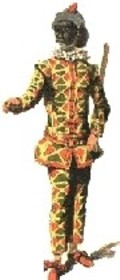
fig.1 Arlecchino
with his
slapstick
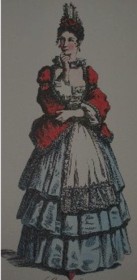
fig. 3 Colombina
Commedia dell'Arte and Fans
Actors,
writers, composers, painters and artists of all kinds have been inspired
by the work of Commedia dell'Arte. Some most obvious influences are
by the work of Elizabethan dramatists, Moliere, Callot, Watteau, Cezanne,
Picasso, Charlie Chaplin, The Marx Brothers, Early 20th Century Vaudeville,
Rowan Atkinson, Mel Brookes.... (Source: http://home.flash.net/~trshane/dellarte.htm).
Its origin is Renaissance Italy, where street actors played a given
role with improvised text. Main characters are the "serious"
doctor, captain, "pantalone", lovers, and the "funny"
"zanni", servants that spice the commedia with "lazzi",
verbal and non-verbal gags.
Most famous are:
Arlecchino: A valet to "pantalone", lazy,
greedy, and a womanizer; the first harlekin was Alberto Naselli 1572
(www.delpiano.com/carnival/html/harlequin.html)
He wears a colourful, patched costume, that got later sewn triangles,
later diamonds as actually known (motley coloured).He wears a black
half-mask on the upper part of the face and a stick with which he bashed
others = origin of "slapstick".
Pulcinella or Punchinello, a male
figure: melancholic, philosophical, stocky, dressed in white, too big
garments. At the early Commedia dell'Arte times, he could be confounded
with
Pedrolino/Piero (Molière called him Pierrot)/Pagliaccio
1570: youngest in troupe of actors, suffers most, must sleep with the
animals in straw (=pagliaio, from there stems his name). White face.
Dreaming character. Pagliaccio was forerunner to nowadays clowns.
Look at a Website of vintage clowns and pierrots postcards: http://www.art-e-zine.co.uk/atcpier.html
Colombina: a lady's servant; in love with Arlecchino
whom she wants to educate. But she makes eyes on other men as well.
She is often depicted in diamond dress like harlekin, and often wears
an apron. She has no mask.
The fan plays a common role in theater. It has a long tradition in the
Japanese Noh-theatre, and fans are used as dancing accessories (most
often stemming from ritual dances) all over the world, including eskimos
. So it comes as no surprise that fan and commedia entered a fruitful
symbiosis.
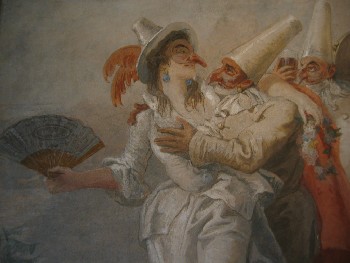
fig. 5 Detail
of Giandomenico Tiepolo's frescoes featuring Punchinelli for the
Villa Zianigo, now in Ca' Rezzonico, Venice, end 18th century
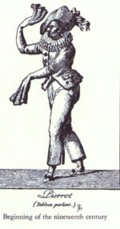
fig. 2 Pierrot,
beginning 19th
century
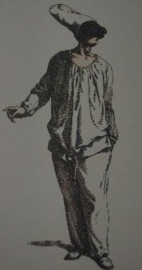
fig. 4 Punchinello
(also: Pulcinella)